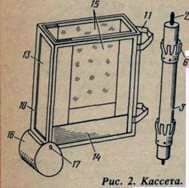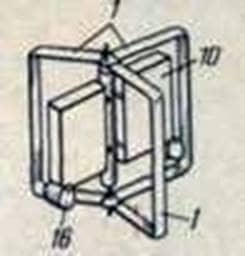 We offer attention to beekeepers developed by us honey. It is demountable, portable, transportable, convenient for operation on nomad apiaries. Our medogonka differs from the usual first of all in that it does not have a tank. In place of it, support frames have been introduced, one of which reinforces the rotor with a vertical axis, and the cassettes are equipped with honey-collecting containers. Support frames are sliding and connected by loops. This allows them to be used as a hard shell base, in which removable parts of the honey extractor are placed.
We offer attention to beekeepers developed by us honey. It is demountable, portable, transportable, convenient for operation on nomad apiaries. Our medogonka differs from the usual first of all in that it does not have a tank. In place of it, support frames have been introduced, one of which reinforces the rotor with a vertical axis, and the cassettes are equipped with honey-collecting containers. Support frames are sliding and connected by loops. This allows them to be used as a hard shell base, in which removable parts of the honey extractor are placed.
The casing of the cassettes is also collapsible. They have vertical and horizontal gutters and side walls. The cassettes are hung on the rotor. The walls of the cassette casing are transparent to monitor their filling with honey.
The honey extractor offered to the reader has the following design features, shown on the proposed drawings.
Thus, in Fig. 1, it is seen that the honey extractor has a fixed vertical axis 2, around it there is a tubular shaft 3 on the bearings. A pinion 4 is mounted on the shaft for transferring rotation from the electric drive 5 or manual drive 8. On the shaft 3 there are hooks 6 for hanging the cassettes 10 .
 In the same figure, it can be seen that with the aid of the brackets of the suspension 11, the cassette is easily hung on the shaft.
In the same figure, it can be seen that with the aid of the brackets of the suspension 11, the cassette is easily hung on the shaft.
A casing comprising a vertical box 13, a horizontal box 14 and two protective glasses 15 is embedded in the cassette 15. A honey collection tank 16 is hung on the outer lower corner of the cassette 10.
The honey extractor is installed in the working position with the help of sliding frames or wire braces, not shown in the figures. The support frames 1 are connected together by means of loops.

Figure 3 shows a honey extractor packed in a sheath. To disassemble and stack the honey extractor, which takes just a few minutes, it is necessary to remove the tins 16 from the hooks, remove the cassettes 10 from the hooks 6, pull out the protective glass walls 15, the vertical box 13, the horizontal box 14. Then remove the manual or electric drives (5 and 8 ). The support frames 1 are folded, forming a rigid base. The cover is fastened.

For work, the honey extractor can be installed both permanently with frames and in the field outdoors.



In the field, it is installed using wire braces.
After installation in the frame 1 axes with a shaft on the hooks 6, cassettes 10 are hung. In them, horizontal boxes 14 are inserted, then vertical boxes 13 and protective glasses 15 are inserted. The tanks 16 are hung onto the hooks of the cassettes, the electric drive 5 or manual drive 8 is installed. In the cassettes 10 The printed honeycombs are inserted and the centrifuge is rotated. Honey from the tanks merges as they fill.
Demountable casing allows you to quickly remove the remnants of honey. Honey from the printed out honeycombs under the influence of centrifugal force is sprayed onto the side walls and drains through the gap between the edges of the vertical and horizontal boxes in the hanging tanks.
Ту для запилення. Навить проволоку.
Fixtures and fixtures